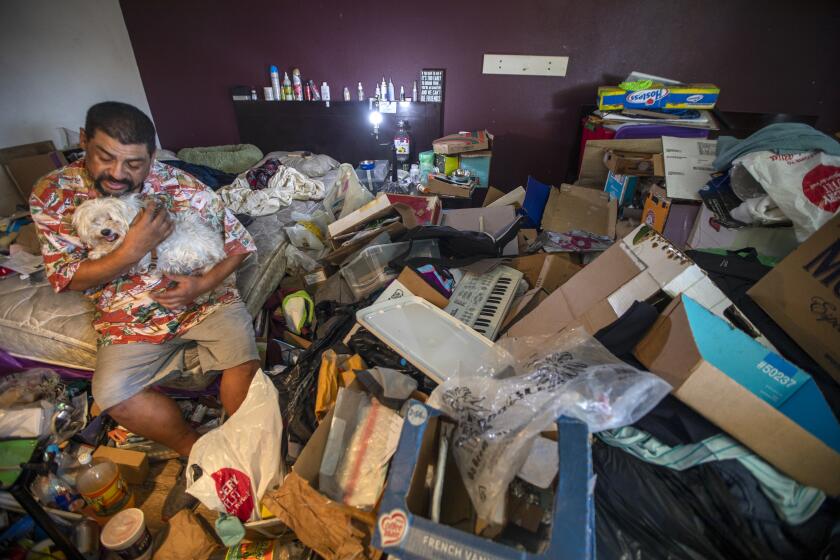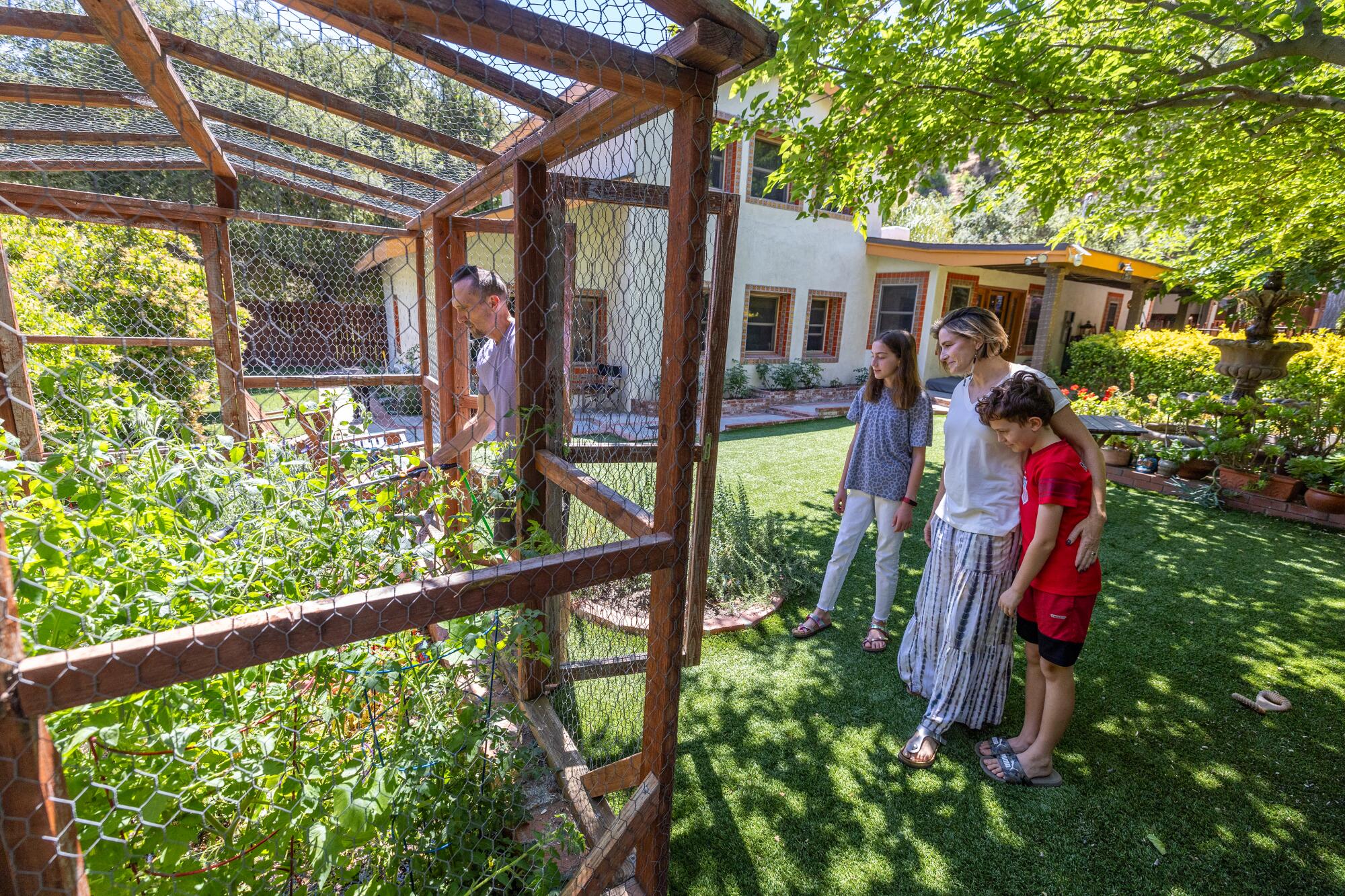
- Share via
For a pair of schoolteachers crammed into a rental with their children, the house for sale in Sun Valley was a dream come true: a modern hacienda with three bedrooms, fireplaces, exposed beams and an open kitchen on half an acre of lush landscaping, with fountains, an orchard and views of the Verdugo Mountains.
“It was so beautiful,” recalled Elena Malone, a history teacher at the private Campbell Hall School, of visiting the property in the northeast San Fernando Valley in 2021. She and her husband, a math teacher at the Buckley School, could barely afford the $1.2-million price. But when she imagined her son and daughter growing up with plenty of space and abundant natural beauty, it seemed worth it.
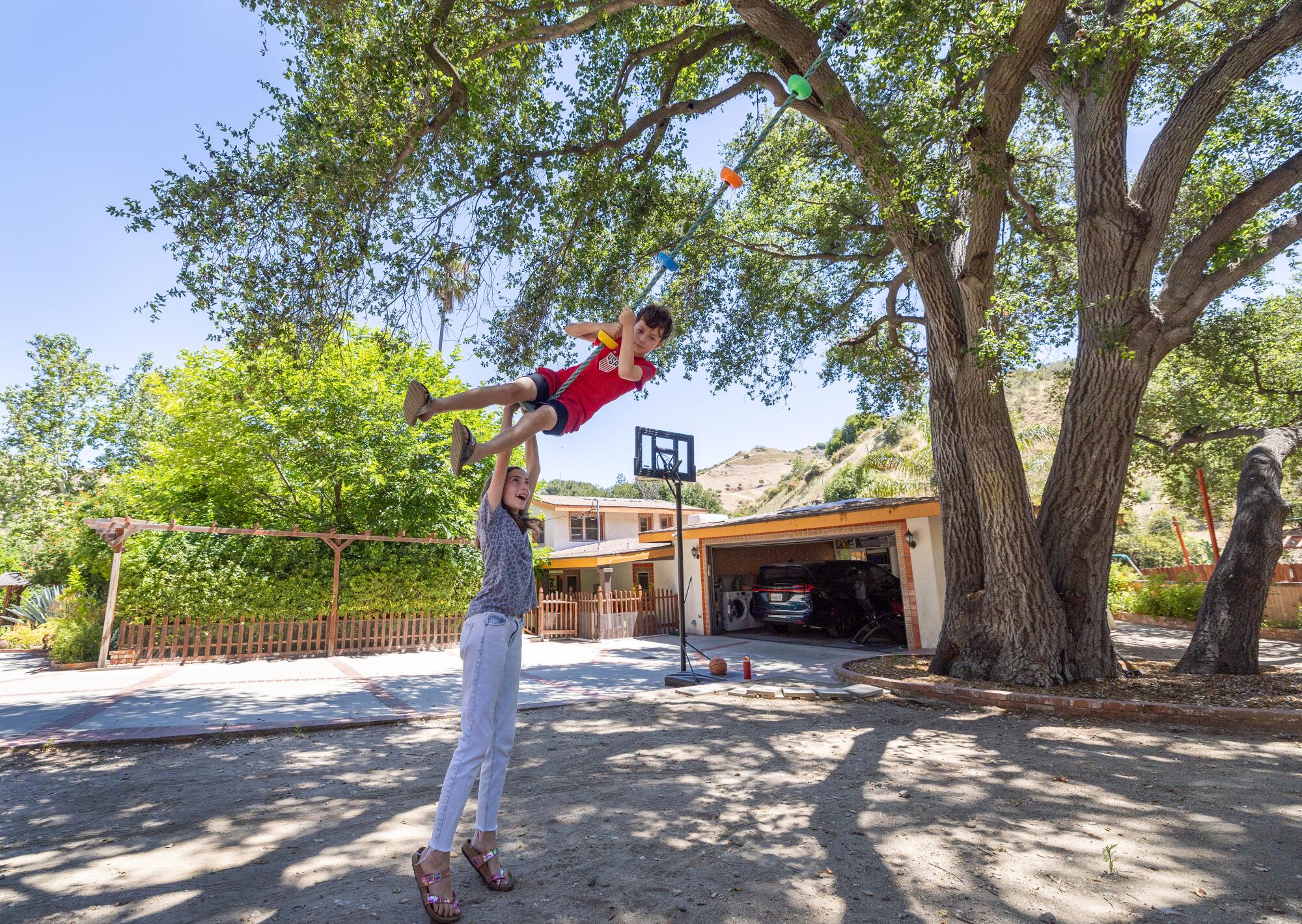
Three years later, the house they fell in love with has become their prison.
A next-door neighbor, described by relatives as a mentally ill hoarder, has turned some six acres of green space into an unlicensed dump with more than a hundred rusting vehicles, mounds of trash and scrap metal, and hazardous waste that has polluted the ground and a nearby streambed.
When the property on Wildwood Fire Road became impassable, the neighbor, 50-year-old David Ferrera, took to living in a car in front of Malone’s house with his girlfriend. Hypodermic needles, bags of marijuana, moldy clothes, human excrement, tires and condoms littered the street, according to neighbors’ accounts and photos taken by Malone.
Strange vehicles blocked her driveway, including on a day last fall when she needed to pick up her husband, Joshua Ryan, from chemotherapy treatments for cancer.
“It’s just not right,” said Malone, who said her children, aged 9 and 11, are no longer allowed to play in the front yard.
Malone, Ryan and others living nearby have begged elected leaders and nearly a dozen government agencies for help for years — with almost nothing to show for it.
Earlier this year, after the Los Angeles city attorney’s office became involved, an exasperated Superior Court commissioner briefly jailed the landowner — the troubled man’s elderly mother. But he trained most of his ire on what he described as the “mind-boggling” failure of government to address the problem.
“They’re taxpaying people that are trying to get some help,” Commissioner Dennis E. Mulcahy lamented. He suggested neighbors might confront City Atty. Hydee Feldstein Soto at her office or demand meetings with Mayor Karen Bass and their council member, Monica Rodriguez. “I can’t understand,” he said, “why the city doesn’t intervene.”
In L.A.’s crisis of homelessness and untreated mental illness, the afflicted themselves bear the greatest burden. But those living alongside them can pay a steep price too. The situation in Sun Valley illustrates how hard it is for residents to get help — even when everyone from the local beat cop to the U.S. Environmental Protection Agency to Ferrera’s own family agrees there is a serious problem.
The desperation Malone and her neighbors feel has intensified in recent weeks with the approach of fire season. La Tuna Canyon is notoriously susceptible. A 2017 blaze there burned more than 7,000 acres. It was the largest fire within L.A. city limits in half a century.
Fires have broken out repeatedly at Ferrera’s illicit junkyard, where there are numerous containers of propane and other flammable liquids. A 2021 fire consumed the home, killing his cats.
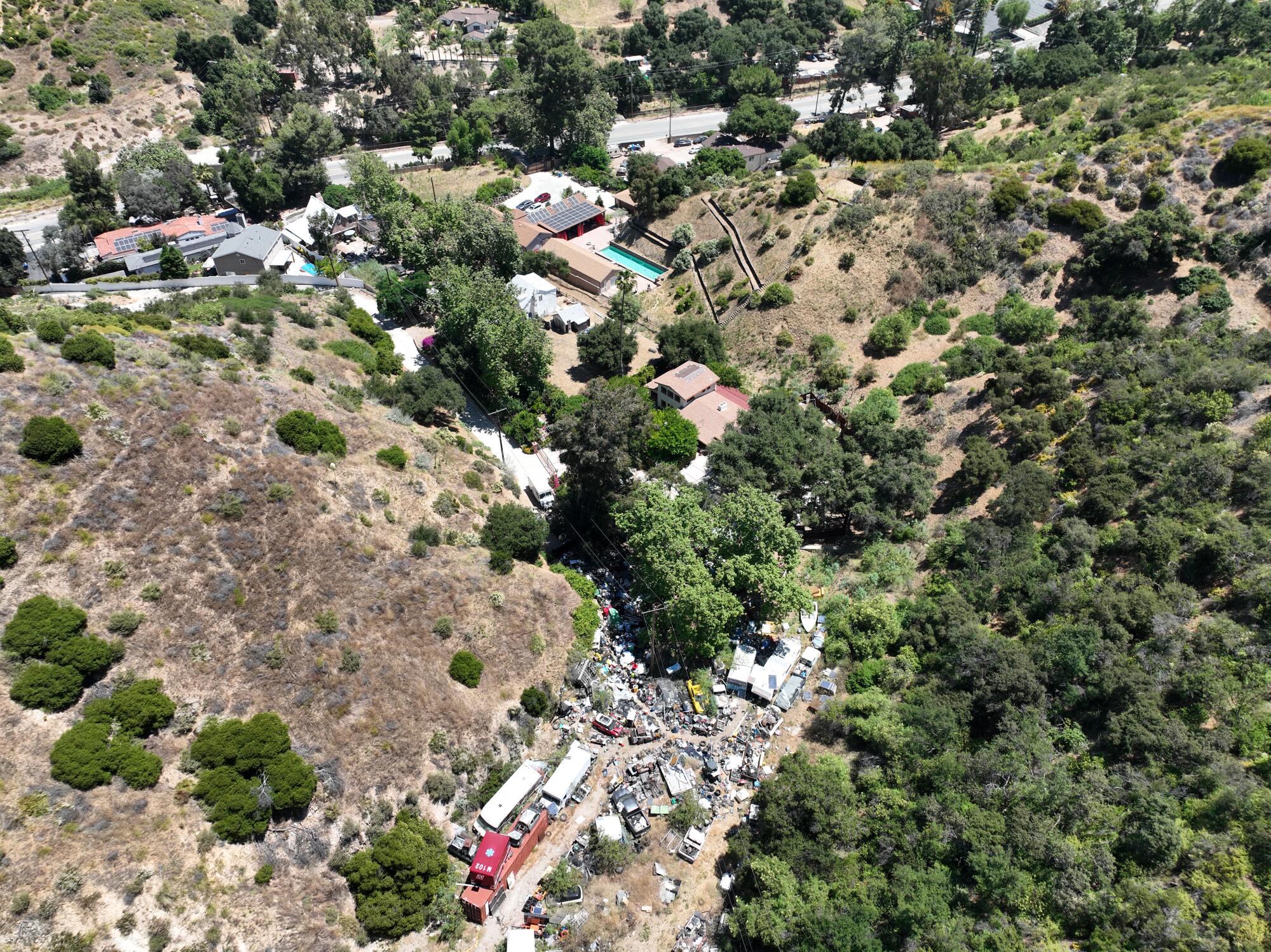
“There are no side streets for us to escape to,” said Scout Raskin, who lives along the narrow lane leading to the property. “If the fire surrounds us, we all die.”
Ferrera did not respond to messages sent through his mother, Mary, or a text to his girlfriend’s phone. The piece of land on Wildwood Fire Road — a street running south from La Tuna Canyon Road — was largely empty before he bought it more than a decade ago.
“It was a real lovely place to walk around,” said previous owner James Hooyenga, describing a hiking trail, a natural spring and a stream that made the area “almost like a park.”
Mary Ferrera, a retired high-school math teacher, took over the deed in 2014, according to property records. She said in an interview that her son couldn’t make the payments but she wanted him to be able to live there. He used his hands to make the place “beautiful,” she said, adding landscaping and building rock walls. “He was so proud of it.”
When wildfire tore through the area in 2017, Ferrera refused to evacuate. A TV news helicopter captured his small figure darting among the flames, an ordeal he told the L.A. Daily News at the time was “awful, like a war zone.” Though his house survived, most of his other possessions burned, including high-end appliances that he had been restoring for sale, according to his mother.
“He began scavenging metal to survive, which may have triggered or worsened his hoarding,” Mary told The Times in an email. The next year, she recalled, slides buried his tools and vehicles in 3 feet of mud. “We think that the trauma of all this, and possibly some unresolved past trauma, led to his acquisition of more and more ‘things’ to replace what was lost.”
An anonymous tipster in 2020 accused Ferrera of operating an unlicensed junkyard and “also dumping chemical drums in the stream,” according to Los Angeles Police Department Det. Supervisor Douglas Larkin. An array of agencies, from the EPA to the state Department of Fish and Wildlife to the county Fire Department’s Health Hazardous Materials Division searched the property the following year.
They counted 114 vehicles, including five the California Highway Patrol deemed “of interest,” suggesting they had been stolen or were suspected of involvement in a crime, according to an EPA report that year. They also found two shipping containers being used as living space, a trailer, dismantled car batteries, leaking high-voltage power equipment and a device that looked like a military-grade bomb. An ordnance disposal team summoned from Marine Corps Base Camp Pendleton determined the object was a practice munition and destroyed its fuse to render it safe, a Marine spokesman said.
Los Angeles Fire Department Battalion Chief Jaime Moore gives details on the mudslides in La Tuna Canyon.
Tests on soil samples taken from the junkyard and a streambed revealed levels of arsenic, lead, cobalt and other substances that exceeded federal safety standards, according to the EPA report, which concluded that the property contained “high levels of hazardous substances.”
Larkin of the LAPD had walked through Ferrera’s property — an otherworldly landscape that included a tipped-over ambulance, part of a jetliner and a giant forklift — but after the discovery of the contamination in 2021, he felt it was unsafe to enter.
“I have told my bosses that we should not step foot on there until it’s been cleaned up,” he said. “It’s horribly dangerous.”
Malone’s family moved into their dream home a few months after the search. She said no one warned them of the major problems next door. Ferrera initially seemed nice, even fixing her garage door and refusing payment.
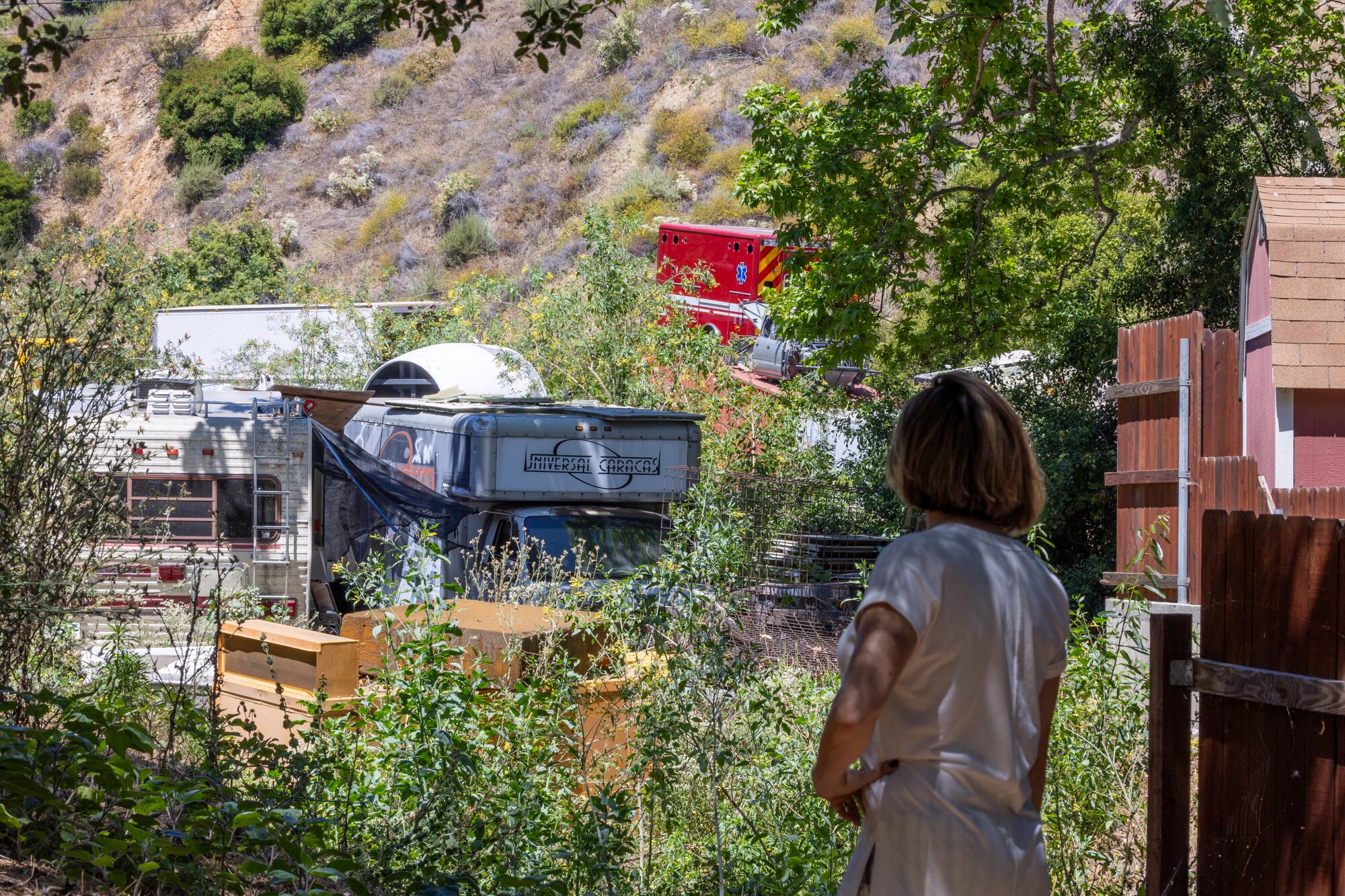
Trash began appearing outside his property on the shared fire road within a few months. At first, it was just fast-food wrappers that Malone tossed in her bins. But the amount of refuse ballooned: inoperable cars, stolen trucks, garbage bags full of marijuana, a sex toy, lubricant. At one point, an injured German shepherd dog was living in the detritus. She was never sure what she would come home to or whether she would be able to get in and out of her drive.
On the day last fall when vehicles blocked her from leaving to collect her husband from chemotherapy, she started shouting in frustration, she said.
“Do you have no soul? ... Do you have no empathy,” she remembers calling out. Ferrera eventually moved the cars. (Her husband is now recovering from cancer of the tonsil and lymph nodes.)
Seeking official help, she met an administrative morass, according to a log she kept of her contacts with various agencies. The city Department of Building and Safety sent her to the city Department of Transportation, which told her the street — a fire road — was private property.
The LAPD said it could tow stolen vehicles — and did on at least two occasions — but was not authorized to remove cars and trucks blocking the street. The state water board referred her to the state Department of Toxic Substances Control. That agency said the EPA was in charge.
Ferrera was living in one of the cars with his girlfriend, and both were sometimes in a stupor, Malone recalled. “I couldn’t wake them up. I was worried they were going to die from an overdose.”
In a tidy ranch home in the hills of La Crescenta, Mary, 80, also worries. She has three gainfully employed adult children in addition to David, whose life sometimes seems controlled by mental illness.
Residents in L.A.’s Fairfax District have long complained to L.A. city officials of overgrown vegetation, mounds of trash and junk.
Nearly every day she drives to the property in Sun Valley. She chats with her son, brings him food and generally reassures herself that he is alive. She knows the neighbors are furious, her land is a sty and her son is living in squalor, but she has not forced him out, cleared away all the trash or sought a court conservatorship.
“I am an enabler, I will agree that I am, but that is because I love my son,” she said in an interview.
In her eyes, Ferrera is more than a neighborhood pariah. She sent The Times a memo of his accomplishments with 14 bullet points. Among them were lending her emotional support after the death of his father when he was 5, getting an A+ on a high school auto shop assignment and saving a friend’s home from the Station fire in 2009.
“David is actually a remarkable human being,” she wrote.
The city attorney charged her with code violations in 2021, and she pleaded no contest to a single misdemeanor — unapproved use of land outside of designated zoning — the following year. As part of her probation, she was to clean up the property, but she made little progress. She told The Times she has paid for the removal of 21 dump-truck loads from the site, only to see her son fill up the space with more junk.
“It’s an addiction,” she said of his hoarding. “It’s one of the hardest mental illnesses to help.”
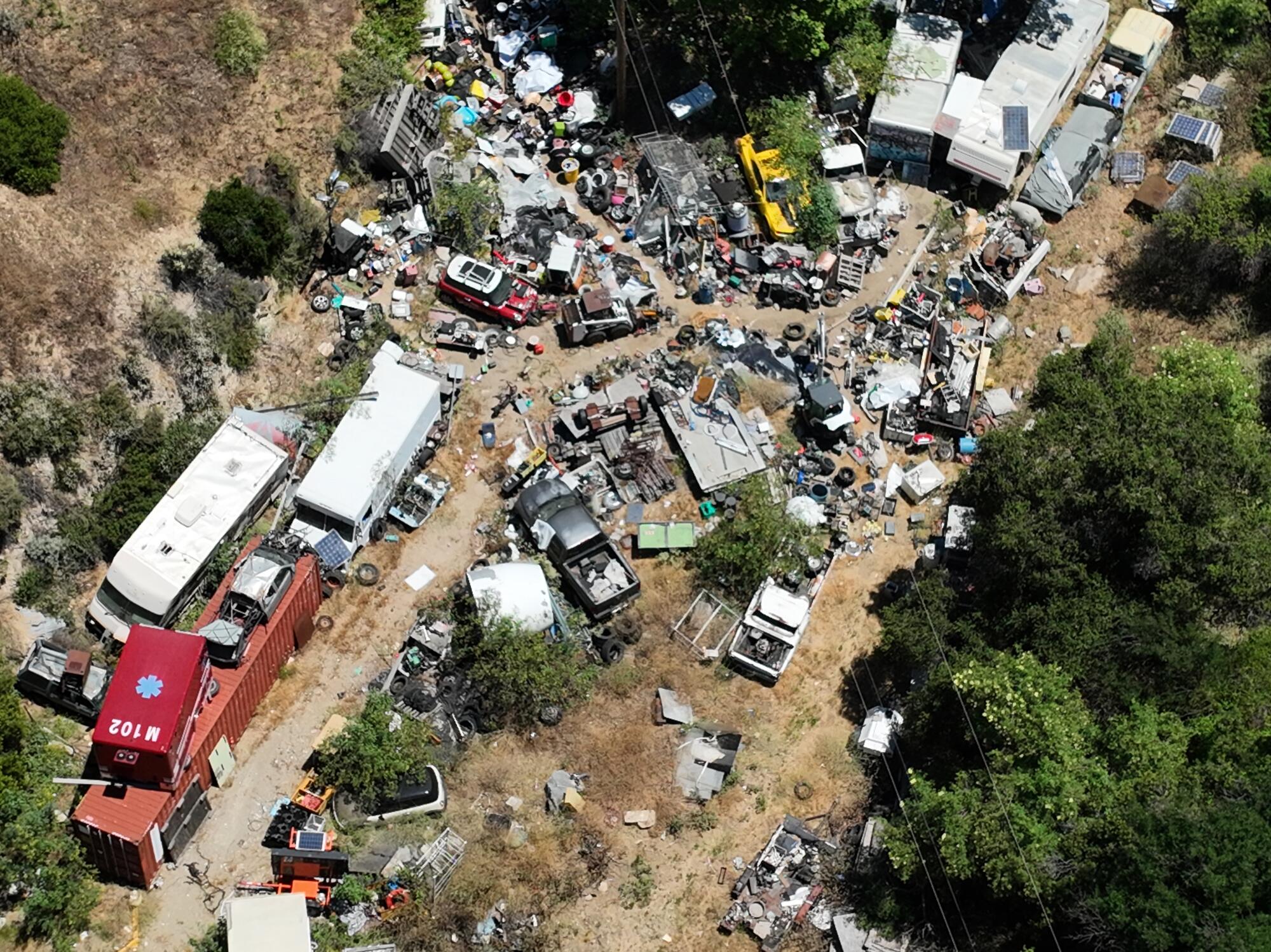
In January, with no real progress evident, the city attorney’s office asked for a jail sentence for Mary. Ferrera did not attend the hearing. His mother told Mulcahy, the court commissioner, that she had tried to sell the property, but that no real estate agent would list it in its current condition.
She offered to take $100,000 from her retirement fund to pay for cleanup, but Mulcahy appeared frustrated by years of inaction and scoffed that the amount was “not even going to be anywhere what the cost is going to be to clean this place up.”
As Mary sobbed, the judge sentenced her to 180 days in jail, acknowledging, “That’s really not the answer, but that’s the only thing I can do.”
The then-79-year-old was escorted from the courtroom by deputies, chained to other inmates in a holding cell, driven to the Twin Towers Correctional Facility in downtown L.A. and made to disrobe in front of guards to put on a jail uniform, she said. After a night in jail, the Sheriff’s Department released her because her offense was a nonviolent misdemeanor.
Her son continues to haul junk he finds on roadsides and in store dumpsters to the property, she said. The city attorney’s office is considering new charges in connection to the property, a spokesman said. The 2021 EPA report called for excavation and disposal of the contaminated soil.
Mary said the agency hasn’t been in contact with her in three years and “dropped us like a hot potato.” An EPA spokesman said its investigation remains open, but the responsibility for cleaning up the property and removing the contaminated soil lies with the owner.
Asked about the hazardous waste’s danger to the surrounding community, EPA spokesman Michael Brogan said in an email that there “is minimal environmental risk presented by the lead contaminated soil as the small, contaminated areas have been isolated and are now considered stable.”
A homeless man with a hoarding disorder bounces between motels under a voucher program. But every move can be devastating.
One neighbor, who asked that her name not be used for fear of antagonizing Ferrera, said she lives in terror of a wildfire starting on his property. When a fire abatement officer recently chided her for not having swept up pine needles in her yard, she said, she pointed to the mess on Ferrera’s land.
“This guy’s got flammable crap up there and chemicals, and you do nothing,” she said. The officer’s reply, she said, was, “Nobody wants to go up there.”
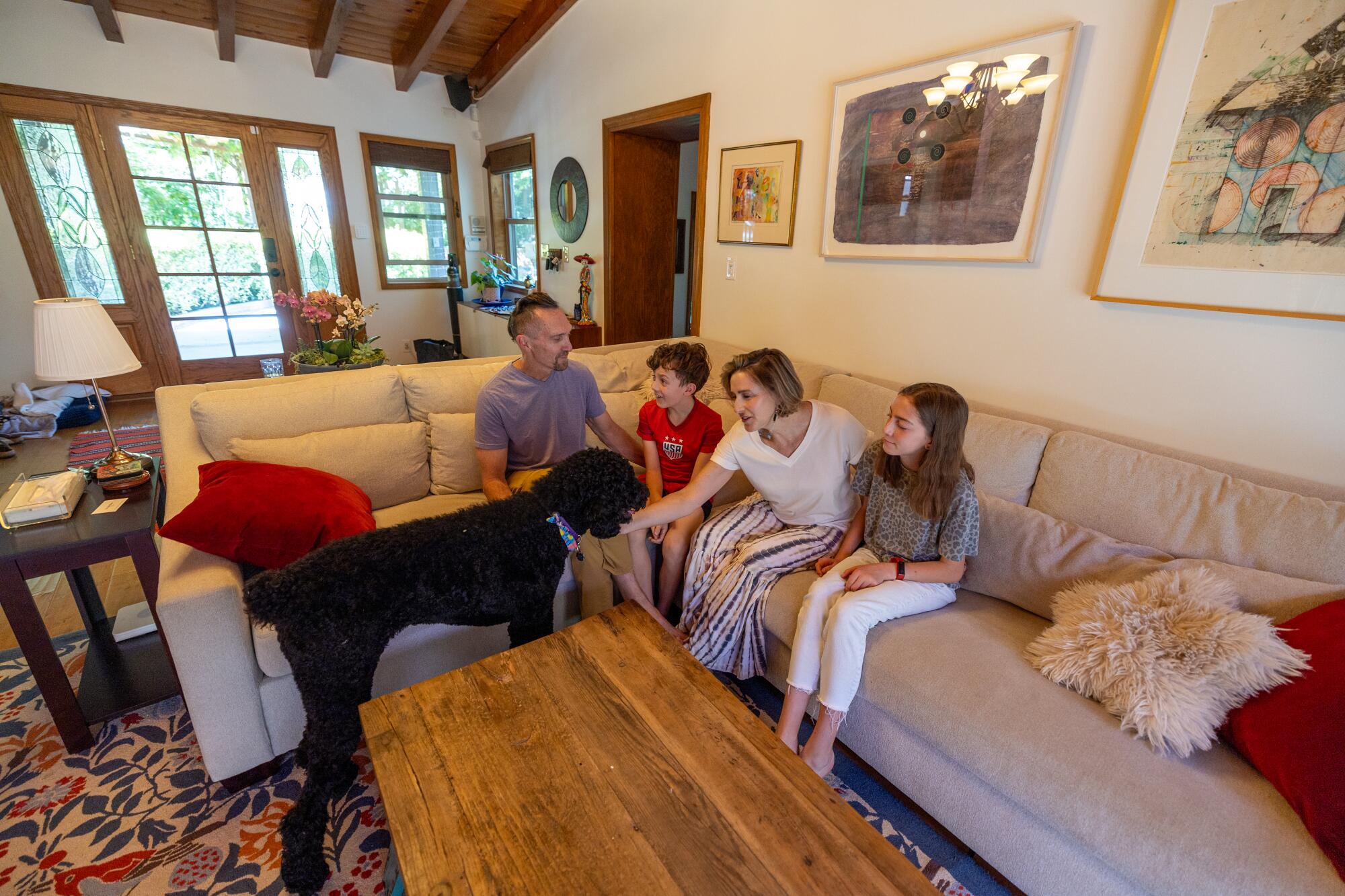
Sitting in her sunny living room, its windows facing away from Ferrera’s property, on a recent morning, Malone said she feels trapped. She wants to move, but she can’t sell the house with a person living in filth in view of the front yard.
She often grapples with how aggrieved to feel. In the classroom, she teaches undeniable horrors like war and genocide and sees herself as fundamentally “lucky.”
“I have a house to live in. My kids get to go to school. We’re not worried about food insecurity,” she said. Still, “I just really feel like one person shouldn’t be able to sacrifice the safety of the community. “
Times staff writer Sandra McDonald contributed to this report.
More to Read
Sign up for This Evening's Big Stories
Catch up on the day with the 7 biggest L.A. Times stories in your inbox every weekday evening.
You may occasionally receive promotional content from the Los Angeles Times.

